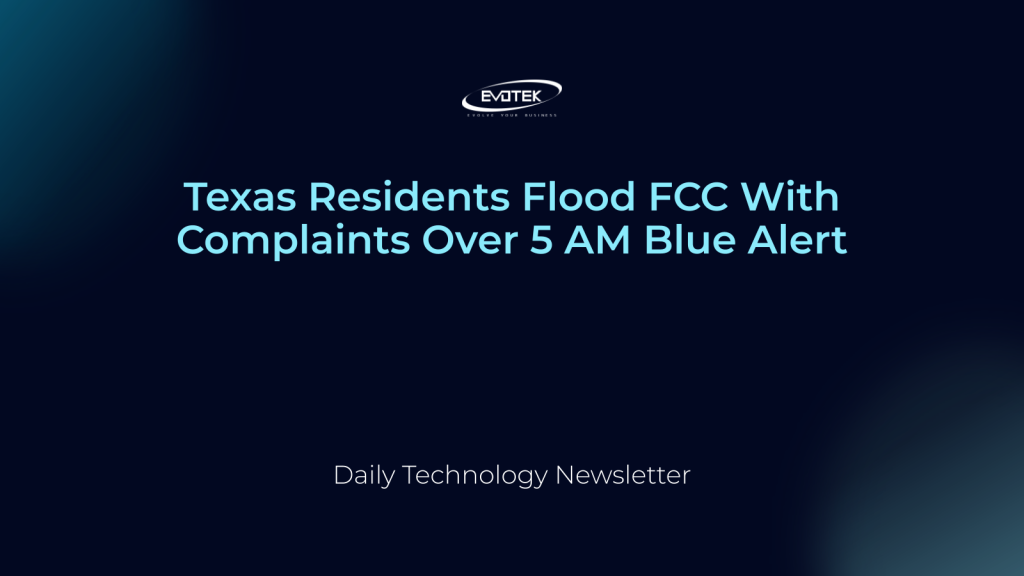NORTH TEXAS – A recent Blue Alert issued in Texas has sparked a wave of complaints to the Federal Communications Commission (FCC), with nearly 4,000 grievances filed after the emergency notification startled residents at 5 a.m.
The alert, issued by the Texas Department of Public Safety (DPS), aimed to locate Seth Altman, a suspect wanted for the attempted capital murder of a peace officer in Memphis, Texas. However, the timing and perceived distance of the incident from North Texas left many questioning its necessity.
“Yeah, so I was about to be up in about an hour or so,” Jordan Stickler said. “Then, I heard the alert come off, and it kind of freaked me out for a second.”
Many North Texans like Jordan Stickler initially mistook the alert for an Amber Alert. Brad Elmore and his wife, Audrey, parents of five children, including a toddler, described the alert as unusually loud and disruptive.
“This one kind of seemed louder than normal for some reason,” Elmore said.
Audrey Elmore was concerned the noise would awaken their baby as multiple devices in their household sounded the alert.
“He pretty much ignored it,” Audrey Elmore said. “It went off on my phone, his phone, our watches, and then my daughter’s phone, so I could hear it throughout the house.”
While acknowledging the importance of public safety, some residents felt the early morning disruption outweighed the potential benefit, especially given the distance of the incident. Others worry that frequent, potentially unnecessary alerts could lead to desensitization.
“But the crazy part was it was eight hours away from here. So it was pretty far away which kind of made me wonder why we’re getting it?” Stickler said.
Brad Elmore said the instances can make the public desensitized to the alerts. DPS said it has to implement the alert when the time calls for it.
“The Texas Department of Public Safety (DPS) is responsible for administering multiple alerts as part of the Statewide Alert Program. Each of these alerts—and the criteria needed to meet them—were established by laws passed by the Texas Legislature,” DPS said.
DPS defended the Blue Alert system, emphasizing its role in rapidly apprehending violent criminals who harm law enforcement officers by generating leads and tips. Blue Alerts have been active in Texas since 2008.
Interestingly, the Elmore family has also experienced the benefits of the alert system. They became benefactors of those alerts. Recently, Brad Elmore’s father went missing for 12 hours. DPS issued a Silver Alert. He was located.
“It may be annoying in the moment, but you know, you got to catch yourself,” Elmore said. “I may need to pay attention because this is somebody’s loved one that’s missing. And you know, I might see a clue that can save their lives.”
The FCC has acknowledged receiving the complaints and is yet to announce how it will address them. The incident has reignited debate about the balance between public safety and the potential for alert fatigue, prompting calls for a review of the current Blue Alert criteria.
Understanding Texas Blue Alerts
What is a Blue Alert?
A Blue Alert is an emergency message disseminated to the public when a law enforcement officer is killed or seriously injured, and the suspect is at large. It aims to engage the public in helping to locate the suspect quickly.
Why are people complaining?
Primary complaints revolve around the timing of the alert (5 AM), the distance of the incident, and concerns that frequent alerts may cause people to ignore future warnings.
What’s next?
The FCC is reviewing the complaints. The Texas Legislature may consider refining the criteria for issuing Blue Alerts to address public concerns while maintaining their effectiveness.

 日本語
日本語 한국어
한국어 Tiếng Việt
Tiếng Việt 简体中文
简体中文